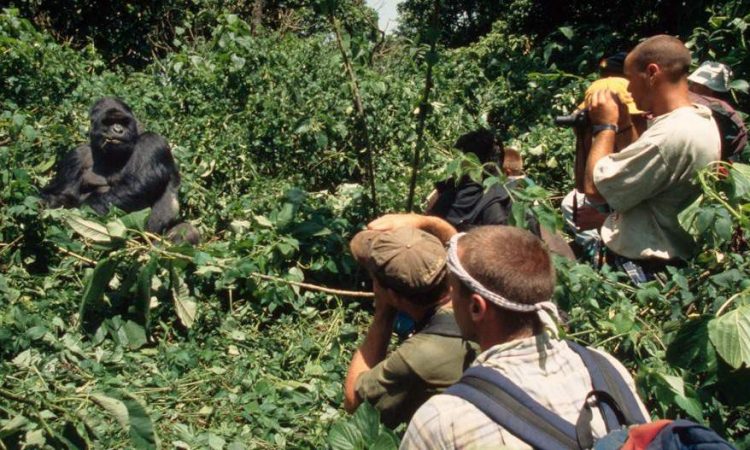A Handy Guide to Gorilla Habituation Experience in Uganda
Gorilla Habituation Experience refers to the process of acclimating wild gorillas to the presence of humans for research and tourism purposes in the Rushaga Sector of Bwindi Impenetrable National Park. It involves gradually familiarizing gorillas with human observers and allowing them to become comfortable in their presence. Gorilla habituation experience in Uganda is a carefully managed process that allows wild gorillas to become accustomed to human presence for research and tourism purposes.
The process of gorilla habituation is carried out by trained researchers and guides who spend extended periods of time with wild gorilla groups, slowly gaining their trust and reducing their fear of human presence. This allows for closer observation and study of gorilla behavior as well as providing a unique opportunity for tourists to have a more immersive experience with these magnificent creatures.
The Gorilla Habituation Experience process typically takes several years and involves a series of stages. Initially, researchers observe the gorillas from a distance gradually moving closer over time. They use non-threatening behaviors and vocalizations to communicate with the gorillas ensuring that they feel safe and secure. As the gorillas become more accustomed to human presence, researchers may begin to mimic some of their behaviors such as feeding or grooming further establishing a sense of familiarity.
During the habituation process, researchers also work to habituate the gorillas to specific behaviors that are necessary for tourism activities. This includes teaching them to tolerate the presence of cameras and tourists at a close proximity. By doing so, it ensures that when tourists visit these habituated gorilla groups they can observe them without causing distress or disruption.

Benefits of Gorilla Habituation Experience in Uganda
- Firstly, it provides valuable insights into gorilla behavior and ecology, contributing to scientific research and conservation efforts.
- By studying habituated gorillas, researchers can gather data on their social structure, feeding habits, reproductive patterns, and other aspects of their lives. Secondly, habituation allows for responsible tourism opportunities.
- Visitors who participate in gorilla habituation experiences have the chance to spend more time with these incredible animals, observing their natural behaviors up close.
- This immersive experience can create a deeper appreciation for gorillas and their conservation needs, leading to increased support for their protection. Lastly, gorilla habituation contributes to the local economy by generating revenue through tourism.
- The fees paid by tourists for gorilla habituation experiences help fund conservation initiatives and support local communities living near gorilla habitats.
- This creates incentives for local communities to actively participate in gorilla conservation efforts and reduces the potential for human-wildlife conflicts.
- These parks are home to several habituated gorilla groups, each with its own set of researchers and guides dedicated to their habituation process.
- It provides valuable scientific insights, supports responsible tourism, and contributes to the conservation of these endangered species.
Difference between Gorilla Trekking and Gorilla Habituation Experience
Gorilla trekking and Gorilla Habituation Experience are two distinct activities that involve observing and interacting with mountain gorillas in their natural habitat.
While both experiences offer unique opportunities to encounter these magnificent creatures, there are several key differences between the two. Gorilla trekking is a popular tourist activity that allows visitors to track and observe habituated gorilla groups in designated national parks.
Gorilla trekking in Uganda involves hikes through forests, following experienced guides who are familiar with the gorilla groups’ movements and behaviors. Trekking usually lasts for a few hours, during which visitors have a limited time (usually one hour) to observe the gorillas from a close but safe distance.
On the other hand, gorilla habituation in Uganda is a more immersive and exclusive experience that involves spending an extended period of time with a specific gorilla group that is undergoing the habituation process.
Gorilla habituation is the gradual process of acclimating wild gorillas to human presence, making them more comfortable and less reactive to human observers. This process can take several years and involves daily visits by researchers, trackers, and conservationists.
During a gorilla habituation experience, visitors have the opportunity to spend up to four hours with the gorillas, compared to the one-hour limit during trekking. This extended duration allows for a deeper understanding of their behavior, social dynamics, and interactions within the group.
Visitors may witness various activities such as feeding, grooming, playing, or even mating during gorilla habituation. The goal of habituation is to ensure that gorillas become accustomed to human presence without altering their natural behavior.
Another significant difference between gorilla trekking and habituation is the level of exclusivity and cost involved. Gorilla trekking costs 700 USD while habituation costs 1500 USD per person for foreign nonresidents.
Gorilla habituation experiences are limited to a smaller number of participants per day, ensuring a more intimate and exclusive encounter with the gorillas. Due to the exclusivity and extended duration, gorilla habituation permits are generally more expensive than gorilla trekking permits.
In summary, gorilla trekking offers a shorter but still remarkable opportunity to observe habituated gorilla groups in their natural habitat. Gorilla habituation in Uganda on the other hand provides a more immersive and exclusive experience.
Gorilla habituation tours in Uganda offer immersive experiences and provide a deeper understanding of gorilla behavior and contribute to their conservation.
Cost of a Gorilla Habituation Permit in Uganda
The cost of a gorilla habituation permit in Uganda is $1,500 per person for foreigners, 1000 USD for Foreign residents and rest of Africa and 750,000UGX for East African citizens. These gorilla habituation permits are limited in number and need to be secured well in advance due to high demand.
During the gorilla habituation process, experienced guides and trackers accompany visitors to ensure their safety and provide valuable insights about the gorillas’ behavior and habitat. The fees for these guides and trackers are typically included in the overall cost.
Additional expenses such as meals, drinks, tips, and other personal expenses should also be considered when calculating the total cost of a gorilla habituation experience in Uganda.
It is important to note that the cost of gorilla habituation in Uganda is relatively higher compared to regular gorilla trekking experiences.
Best Time to Go For Gorilla Habituation Experience
You can track mountain gorillas in Uganda all year round with consistent temperatures ranging from 20-25°C. The best time for gorilla trekking and gorilla habituation experience is the dry seasons from June to August and December to February. During these months, the primates retreat into the dense forest during the rains and the jungle is less muddy and slippery for trekking.
The heavy wet season runs from March to May with a second lighter rainy season falling in October and November. Although you can still go trekking to see mountain gorillas be aware that the trails can be quite muddy and harder to navigate. The wet season can also offer the best conditions for gorilla photography as after a rain shower the air is clear of dust providing a stunning atmosphere to capture the gorillas.
What to Pack for a Gorilla Habituation Experience in Uganda
It is advisable that you come well prepared for the incredible Gorilla Habituation experience in Uganda.
Here’s our recommended packing list for an amazing gorilla habituation experience in Uganda:
- Sturdy, waterproof hiking boots with good ankle support
- Light, breathable, waterproof jackets, trousers and long-sleeved shirts
- Long, lightweight woolen socks
- Wide-brimmed hat and sunglasses for sun protection
- Toiletries such as sun cream, insect repellent, bite relief cream and lip balm
- Garden gloves
- A small backpack to carry your water, lunch, binoculars and camera
- Camera with extra lenses and batteries
- Binoculars
- Snacks for extra energy
- Multi-way travel adaptor
Contact us to tart planning your gorilla habituation experience tour in Uganda
